Washoku (Japanese Food)

Washoku (Japanese Food) / 和食
Inscribed in 2013 on the Representative List of the Intangible Cultural Heritage of Humanity of UNESCO, "Washoku" is a social practice based on a set of skills, knowledge, practice and traditions related to the production, processing, preparation and consumption of food, associated with an essential spirit of respect for nature that is closely related to the sustainable use of natural resources. Recognized for comprising healthy dishes with outstanding nutritional balance using stock made of fish, dried kelp, or dried seaweed to avoid excessive consumption of animal-based fats combined with side dishes, rice, "tsukemono" [pickled vegetables], using ingredients best suited for the geography and climate a striking presentation, as "Washoku" is also intended to be enjoyed visually. Another feature of "Washoku" is the deep connection with annual events.
The fundamental concept of "Washoku" is "ichiju-sansai" (literally one soup and three dishes) comprising the staple of rice and miso soup with a main dish of fish or meat and two side dishes of vegetables, mushrooms, seaweed, and more. Providing a well-balanced, healthy meal to intake carbohydrates from the staple, protein and fat from the main dishes, and vitamins and dietary fiber from the side dishes.
"Washoku" has many different categories, as soba, sushi, and some other cuisines differ in appearance to food made with the fundamental concept of "ichiju-sansai".
The following is the traditional "Washoku" that the Japanese nationals have dined on since the time of immemorial.
Kaiseki-ryori (multiple cuisine) / 会席料理

“Kaiseki-ryori” is a simplification of its formal, ancient counterpart, honzen ryori, and was developed to enjoy banquet-style dining indulging with tastebuds and eyes, a visually pleasing cuisine based on the “ichiju-sansai” concept. Typically served in the specific order of appetizers, clear soup, sashimi, simmered dishes, grilled dishes, fried dishes, then, rice and dashi [broth]-based soup. “Kaiseki-ryori” is ideal for savoring slowly while drinking Japanese “sake”.
Sushi / 寿司
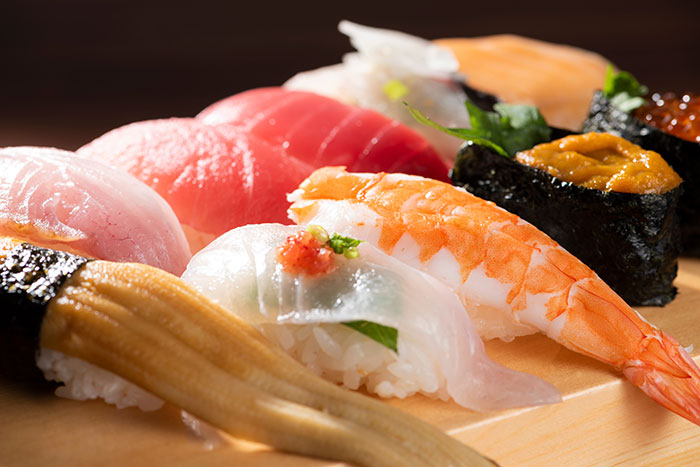
"Sushi" is made with vinegared rice and fish or other food. There are varieties of sushi, of "nigiri" made by placing slices of food on top of the vinegared rice, "maki-zushi" (sushi roll) made by wrapping rice and ingredients by seaweed, and "chirashi-zushi" made by sprinkling seafood, egg omelets, vegetables for garnish on vinegared rice. Besides the sushi restaurants where the sushi master conjures up delectable sushi in front of you, and as a more affordable and popular dining option, the "kaiten-zushi" [sushi-go-round] restaurant where sushi is carried directly to your table on a conveyor belt.
Soba / そば
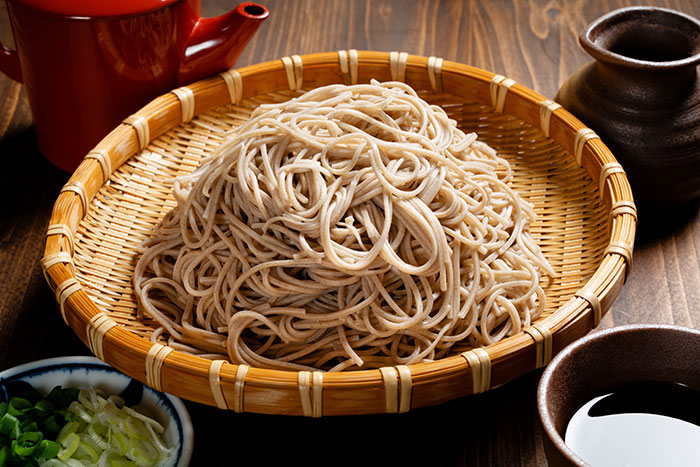
“Soba” is a type of noodle made of grinding buckwheat seeds, into buckwheat flour, mixed with water and knead to batter, rolled out thin and cut long and thin. “Soba” dates far back in history of Japan and is believed to have been grown for over 9,000 years. The different kinds of soba noodles are “kakesoba” served in hot soup, “morisoba” served cold with a noodle soup to dip in, “kitsunesoba” [literally “fox soba”] characterized with the deep-fried tofu on top, “tanuki soba” [literally “racoon dog soba”] with freshly fried “tenkasu” [crumbs of tempura batter] on top, and “tempura soba” served with various tempuras.
Udon / うどん
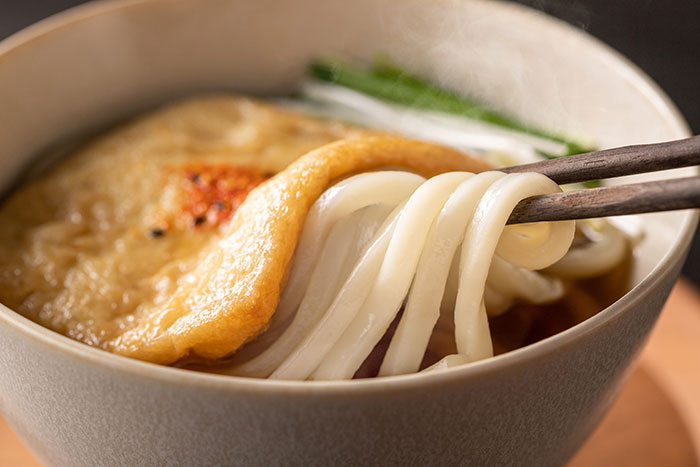
“Udon” is a type of noodle made with flour and water into batter kneaded and stretching it out before cutting into thin strips. “Udon” differs from “soba” from that is more thick and more firm in texture. “Udon” is served in varying thicknesses and hardnesses depending on the region of Japan visiting. “Udon” was eaten in ancient times as an alternative to rice when rice harvests were scarce. The “tsuyu” [sauce] that accompanies “udon” has a more distinct “dashi” [broth] flavor than that for soba. Enjoy various types of “Udon” while visiting different areas of Japan.

Alcoholic Beverages
Japanese "Sake" / 日本酒
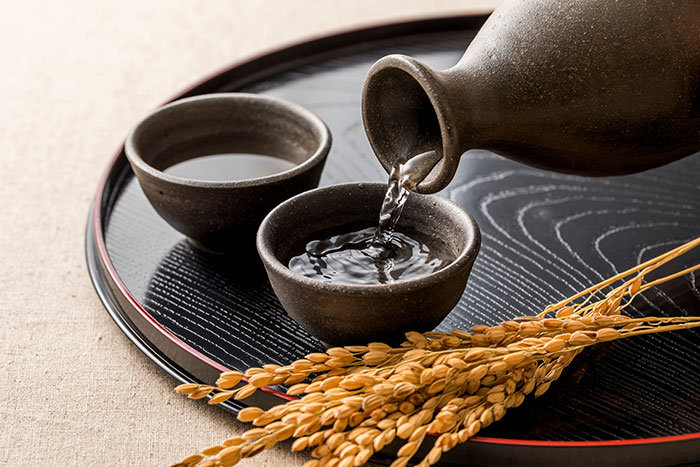
Japanese “sake” is a brewed alcoholic beverage made in Japan exclusively from domestically grown rice and rice malt. The process of adding rice malt and water to the rice and fermenting it is extremely complex, thus demanding great skill. Depending on the brewing technique or rice preparation, Japanese sake comes in many different types, including “junmai-shu” [pure sake] and “ginjo-shu”. Japanese “sake” is enjoyed hot and cold and is the ideal complement to the traditional Japanese cuisine - “washoku”.
Shochu / 焼酎
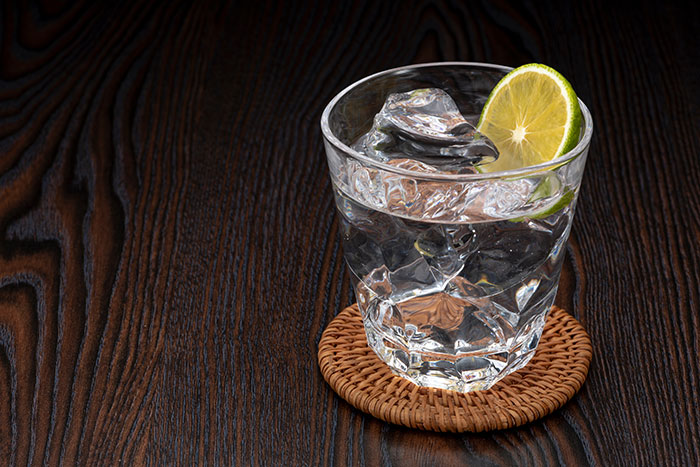
“Shochu” is a distilled alcohol made from potatoes, grains, or other ingredients. As it is distilled, “shochu” is high in pure alcohol. Commonly enjoyed straight, also enjoyed “on the rocks”, mixed with water, hot water, green tea, carbonated soda, or fruit juice. Find the “shochu” best suits the tastebuds!

Japanese Traditional Sweets (Wagashi)
Jo-namagashi [Fresh Wagashi] / 上生菓子
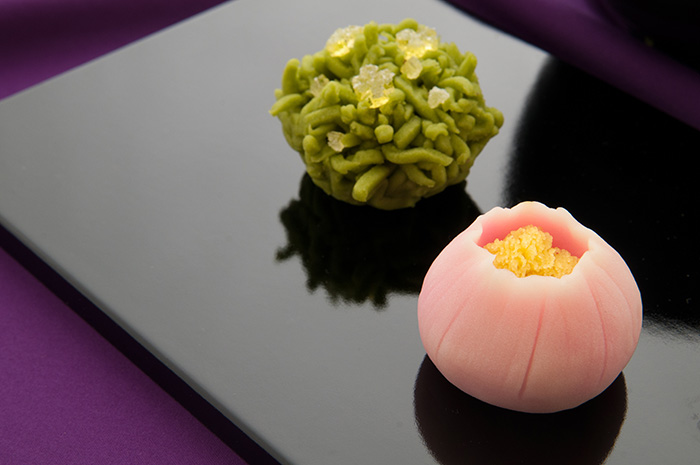
In Japan, sweets containing water of 30% or higher are known as "nama-gashi", and “Jo-gashi” are premium Japanese confections with a stunning appearance. Painstakingly created one by one to representing season or element of nature and are indispensable in traditional Japanese tea ceremony. Rice, sweet potatoes, beans, sugar, agar, and other ingredients are used to produce beautiful designs from naturally derived dyes.
Taiyaki / たい焼き

“Taiyaki” is a seabream-shaped pastry made from grilling batter of flour and water and typically filled with red bean paste. These tasty treats come with a variety of fillings, including "tsubuan" [a type of red bean paste where the beans are not completely crushed], "koshian" [smoothened red bean paste], custard cream, chocolate cream, and more. “Taiyaki” is an affordable and much-loved street food.
